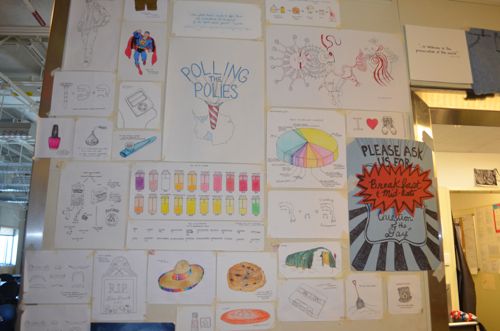Welcome to the South Pole
Before arriving at the South Pole, I imagined I would find a much starker environment than that of McMurdo. Although the South Pole houses far less people (typically they have 150 - 250 people here in the summer, as opposed to McMurdo's 1000 - 1200), they still have more than adequate facilities to make staying at the pole comfortable.
Jamesway Tents
Instead of staying in a dorm, like I did at McMurdo Station, I stay in a Jamesway Shelter. Jamesways are large tents that are sectioned off into small rooms that are approximately 6 by 8 feet. Instead of a door, cloth covers the door opening. The walls in the room are made from cloth or wood. The Jamesways were originally created for the Army Air Corps during the Korean War. Wooden arches, about 4 feet apart from each other, provide a frame for the shelter. Fabric is then stretched over the arches. Jamesways are surprisingly warm and a vent provides heat to each room. Although it is a rugged accommodation, I had no problems falling asleep in my little room last night! Other scientists and staff stay in the Berthing Pods within the main South Pole station building. I have not yet investigated what they look like, but they are supposedly nice.
 Michelle Brown's small room in the Jamesway tent includes a bed, a humidifier thanks to Andy, and a shelf.
Michelle Brown's small room in the Jamesway tent includes a bed, a humidifier thanks to Andy, and a shelf.
 Rows of Jamesways tents make up the summer camp area at South Pole Station. The buildings in the middle host a lounge, laundry and bathrooms. Photo courtesy of USAP.
Rows of Jamesways tents make up the summer camp area at South Pole Station. The buildings in the middle host a lounge, laundry and bathrooms. Photo courtesy of USAP.
The Galley
The galley is where we eat. Again, it is a smaller accommodation than McMurdo, but the food is outstanding! For lunch I ate rice, veggies, hush puppies, salad (grown in the greenhouse here), and resisted a tempting dessert. T.V. screens in the galley update diners on flights coming in, the weather, and when the internet will be available. We only have access to the internet when overhead satellites pass by. Today I met an artist who works in the galley. She draws pictures and surveys people on topics as they drop off their dishes and silverware. Check out some of her work!
 Andy Stillinger displays the juice and water station in the galley
Andy Stillinger displays the juice and water station in the galley
 A view of the galley before dinner.
A view of the galley before dinner.
 Dining attendant and artist, Sydney, creates clever artwork that is posted in the dish washing area.
Dining attendant and artist, Sydney, creates clever artwork that is posted in the dish washing area.
The Science Lab
The Science Lab is a place for different scientists and engineers to work. An interesting project that has an office in the Science Lab is the IceCube project. They drill holes in the ice that are 2,450 meters deep, and then place sensors called Digital Optical Modules in them to detect neutrinos. There are 5,484 sensors in the ice! The research that IceCube and other projects are conducting at the South Pole originated from research stemming back to 1912 when an Austrian physicist discovered that atmospheric radiation rose as a balloon he sent into the air rose. Today there are five projects at the South Pole that study energy coming from the edge of the universe: The IceCube project, the Askryan Radio Array, DM-Ice, The South Pole Telescope, and BICEP. Hopefully I will learn more about these projects in my short stay here.
 Andy Stillinger is hard at work at the AGO table in the science lab.
Andy Stillinger is hard at work at the AGO table in the science lab.
 Fabian Clebermann, a researcher on the IceCube team, sits in his office in the science lab.
Fabian Clebermann, a researcher on the IceCube team, sits in his office in the science lab.
Questions
What are the pros and cons of staying at McMurdo Station? (Look at the journals from http://www.polartrec.com/expeditions/human-impacts-in-antarctica-2011/journals for help) What are the pros and cons of staying at the South Pole Station? Which would you rather stay at and why?
Math Connection
How many more people (on average) live at McMurdo as compared to the South Pole Station?
If there are 10 rooms in the Jamesway (5 on each side), that are 8 feet long (along the Jamesway's long sides) and 6 feet wide, with a 4 feet wide hallway between rooms, what is the area of a Jamesway?
